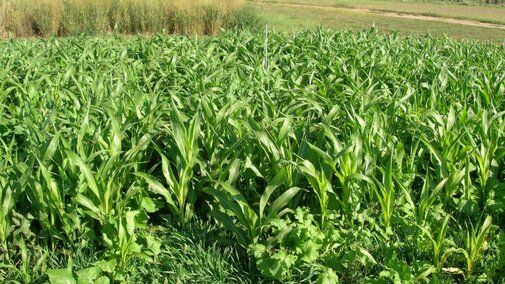Corn Silage Harvest Considerations
Corn silage harvest is just around the corner and timing harvest right is critical to silage harvest success. Two factors to pay close attention to are whole plant moisture and milk line.
Accurately assessing whole plant moisture is key to proper fermentation of the silage pile and getting a good pack. Too dry and packing is difficult, oxygen gets into the pile. Overheating, mold/yeast/bad microbe growth and spoilage follow. If we harvest too wet, the pile weeps and energy and nutrients are lost. Also of danger here are the growth of clostridia bacteria colonies, which we really want to avoid. Ideally, we want to harvest at 65-70% moisture.
The other factor we have to consider when chopping is milk line. This is a visual indicator of how much starch the corn plant has set down in the kernel and how much is still wet “milk”. Starch is one of the most energy dense feed components we have, so silage that contains higher amounts of starch will be higher energy overall. The further down the kernel the milk line is, the more starch we end up having.
The trouble is that plant moisture and milk line aren’t directly correlated and may vary among hybrids. While they do tend to trend in the same direction, you might have a year where corn that is 55% moisture and ¼ milk may be 65% moisture at the same ¼ milk the next field over. Both variables need to be watched. Exactly when to pull the trigger is dependent on each operation’s resources and needs but can be a very short window for an optimal product.
Corn silage is a great feed resource that can benefit greatly from some extra care and planning at harvest. Keep an eye on total plant moisture (65-70% for best results), and milk line (closer to the cob means more starch and higher energy silage) to find your ideal harvest window.
Corn Silage Storage and Protection
By Brad Schick
Cover the silage pile.
The time and money spent on chopping silage for feed does not go unnoticed, but if the pile isn’t covered, the loss of feed will be noticeable. Even after the silage is packed correctly, air and water can penetrate the outer layers and severely damage the quality and quantity of silage. Additionally, molds, mycotoxins and fungi have a prime place to grow in uncovered silage.
Many studies at Kansas State University have reported a minimum 3% loss in dry matter from the top three feet of silage in uncovered silage bunkers compared to covered. Much like the last span of a pivot irrigates a large percentage of a field, the outer portion of a silage pile makes up a large portion of the pile. Covering with plastic will give about an 8:1 return on investment for the producer.
Silage should be covered as soon as possible with plastic. The standard plastic is still the black and white sided 6mil sheeting. Some producers may also add an additional layer of oxygen barrier plastic to reduce dry matter loss and spoilage even further. Another option is to use one sheet that is thicker or made of different material and is more of an oxygen barrier than the standard plastic. Make sure the edges are sealed and the top has plenty of weight on it. Usually tires cut in half are the most common.
An 8:1 return on investment isn’t easy to find these days, but it is right here with covering silage with plastic. Covering isn’t the easiest job but returning the favor with neighbors or providing incentives will make the job a whole lot easier.
Forage/Cover Crops Following Corn Silage
Cover crops can complement corn silage systems, especially when soil erosion protection is a concern. As the name implies, cover crops provide “cover protection” for bare soils subject to erosion by rain droplets when residue has been removed. Beyond erosion benefits, the choice of cover crops usage as a single plant species or mix may be further based on soil health goals; growing season remaining after silage harvest; intended cash crop for the upcoming year; and economics.
If corn silage harvest occurs early enough in the fall such as mid- to late August; both small grains and brassica will likely have enough time to produce favorable forage yields (when moisture is not a limiting factor). Research indicates that cover crop forage production will double for each month that the fall growing season can be extended. As planting dates move later into the fall, there may be less usage of brassica plants such as turnips, canola and radishes. Among the small grain cover crop choices, cereal rye is usually the most preferred species choice for fall and early spring growth and grazing. Oats, winter wheat and triticale may also provide fall forage grazing, but cereal rye breaks dormancy earlier in the spring. Thus, rye will potentially provide more spring forage production if corn will be the intended crop planted on previous silage fields.
Oats, wheat, triticale and barley may be preferred if the intended next crop can have delayed spring planting.
The bottom line is that living plants can protect soils as well as provide grazing forage.

